
Haystack Rock dominates the landscape at Cannon Beach. The wet sand, dramatic skies, and great light combined for some great images. Canon EOS 5D Mark III, EF 24-70 f/2.8L II at 24mm. 1/40 second at f/16, ISO 200. I used a 4 stop graduated neutral density filter on the sky.
Every year I try to dedicate at least one week of vacation to photographing a destination that’s on my lifetime list of places to see- some might call it their bucket list for photography. The past few years those trips included Yosemite, Acadia, and Denali. I have wanted to photograph the Oregon coast since I first began photographing landscapes, and decided that this year was the year for that.
I had seen photographs of the beaches in Oregon and knew they were beautiful, but nothing prepared me just how beautiful they really were. And nothing prepared me for the diversity of the landscape. From wide sandy beaches, to towering sea stacks, rocky headlands, and temperate rainforest, the coast of Oregon offers a little of everything to photographers seeking dramatic landscape images. I was in heaven. For this trip, I took along the following: EOS 5D Mark III, EF 16-35mm f/2.8L II, EF 24-70 f/2.8L II, EF 70-300 f/4-5.6L IS, EF 100mm f/2.8L IS macro, and EF 14mm f/2.8L II. I had my lightweight travel tripod (a Gitzo 1541T), and my set of 4×5 inch graduated ND filters and ND filters, as well as a polarizer.
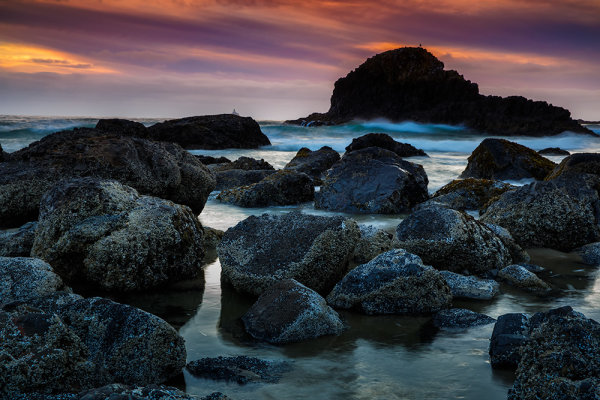
Indian Beach features a rocky area along with a wide expanse of sand. On this day, gray clouds had been hanging around all day, keeping the light pretty flat and boring. Just as the sun began to set, the layers of clouds separated and began reflecting this unbelievable color. To capture it, I used both a 3 stop hard edged graduated neutral density filter, stacked on top of a hard edged 4 stop graduated ND. That brought out the color nicely and allowed me to maintain good detail in the foreground. 1/15, f/16, ISO 400. EOS 5D Mark III, EF 24-70 f/2.8L II at 50mm.
I stayed in Cannon Beach, and was immediately drawn to the dominant feature of the landscape, Haystack Rock. At 235 feet tall, Haystack Rock towers above everything else in the area. Cannon Beach, like much of the coastline, features sand pounded flat by the tides, so you can see for miles down the beach. When the sand is wet, it becomes highly reflective, and since the beach is so flat, the water just keeps running over the sand. This presents fantastic opportunities for reflections. In addition, the water and wind will carve the sand, creating patterns that just beg you place it in the foreground using a wide angle lens. Finding interesting compositions of the monolithic Haystack Rock can keep any photographer going for days.
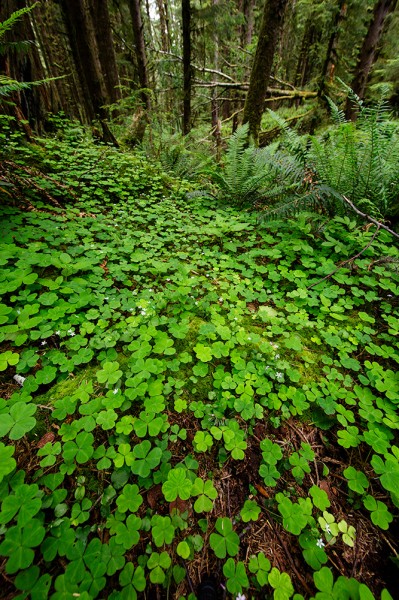
The temperate rain forest features a plethora of flora. This is wood sorrel blanketing the forest floor. EOS 5D Mark III, EF 14mm f/2.8L II. 1/25, f/8, ISO 400.
Low tide is a macro photographer’s dream. You can walk all the way out to Haystack Rock, where tide pools form around smaller rocks. These tide pools feature a plethora of marine life, including crabs, star fish, limpets, ochre sea stars, and sea anemone, among others. One can spend hours amongst the tidal pools, alternating between landscapes and macro work, and still not exhaust all of the opportunities presented.
Just north of Cannon Beach is Ecola State Park. Ecola State Park is a mix of rocky headlands, temperate rain forest, and sandy beach. I spent half a day photographing in the rain forest. Trees covered in moss, ferns and wood sorrel blanketing the forest floor, and winding trails lead to tons of photographic opportunities.
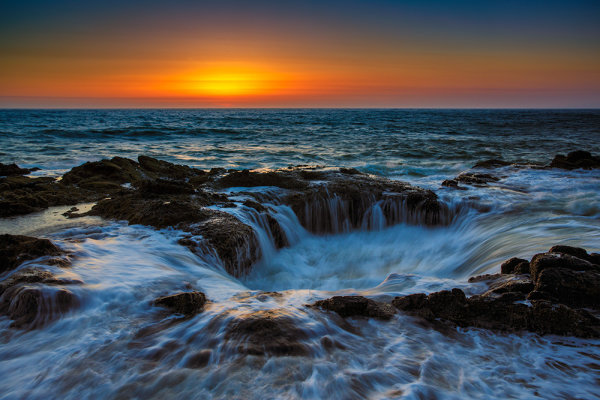
Thor’s Well, at Cape Perpetua, is breathtaking in showcasing the ocean’s power. EOS 5D Mark III, EF 24-70, f/2.8L II, at 31mm. 1/5, f/16, ISO 100. Due to the spray I was unable to use a graduated neutral density filter, so in the raw processing I pulled the exposure for the sky back using a digital graduated filter in Adobe Camera RAW.
South of Canon Beach is a stretch of beaches and state parks such as Arcadia Beach, Oswald West State Park, Hug Point State Park (which features a beautiful waterfall), and more. A few hours further south is Cape Perpetua, which features some of the most dramatic coastline I’ve ever seen. Specifically, the area around Devil’s Churn, which features waves crashing on the rocks like thunder, water being forced out of blow holes, and a cauldron-like feature called “Thor’s Well”. This area is best photographed at high tide, where the waves create massive splashes, and Thor’s Well literally boils over. While I was there, the wind was blowing spray all over the camera, making it a nightmare trying to keep the camera dry.

From Ecola State Park, you can view the vast expanse of Cannon Beach below. EOS 5D Mark III, EF 70-300 f/4-5.6L IS, with a 5-stop and 6-stop ND filter stacked together to create the long exposure. 30 seconds, f/25, ISO 160.
I could not believe how many good photo ops there were waiting for me in Oregon, and I didn’t even get a chance to explore the Columbia River Gorge or the southern coast. I definitely plan to go back and explore more, so it stays on my list. And I must go back for a marionberry scone from the Lazy Susan Cafe in Cannon Beach!
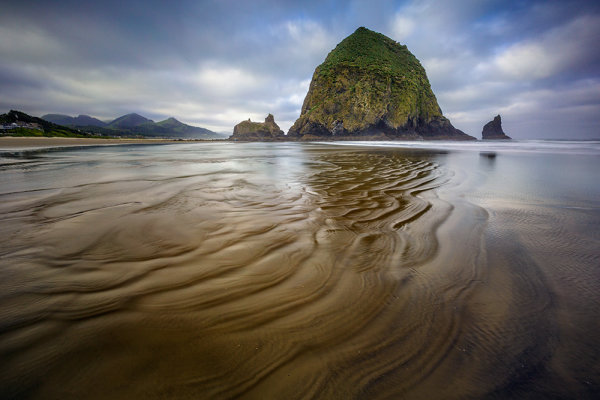
Wind and Water carved up the sand on the beach, creating a great foreground to use for this shot. EOS 5D Mark III, EF 16-35 f/2.8L II. Exposure was 4 seconds, f/16, ISO 100. I used a 3 stop, soft edged graduated ND filter to help darken the sky, and a 6 stop ND filter to slow down my exposure.
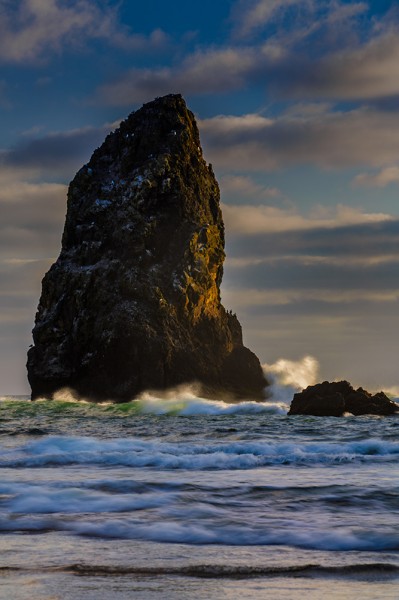
The Needles are the tall, thinner sea stacks to the south of Haystack Rock. I photographed this with the EOS 5D Mark III and EF 70-300 f/4-5.6L IS. 1/10, f/16, ISO 200.
Post originally from: Digital Photography Tips.
Check out our more Photography Tips at Photography Tips for Beginners, Portrait Photography Tips and Wedding Photography Tips.
Destination: Oregon
You must be logged in to post a comment.